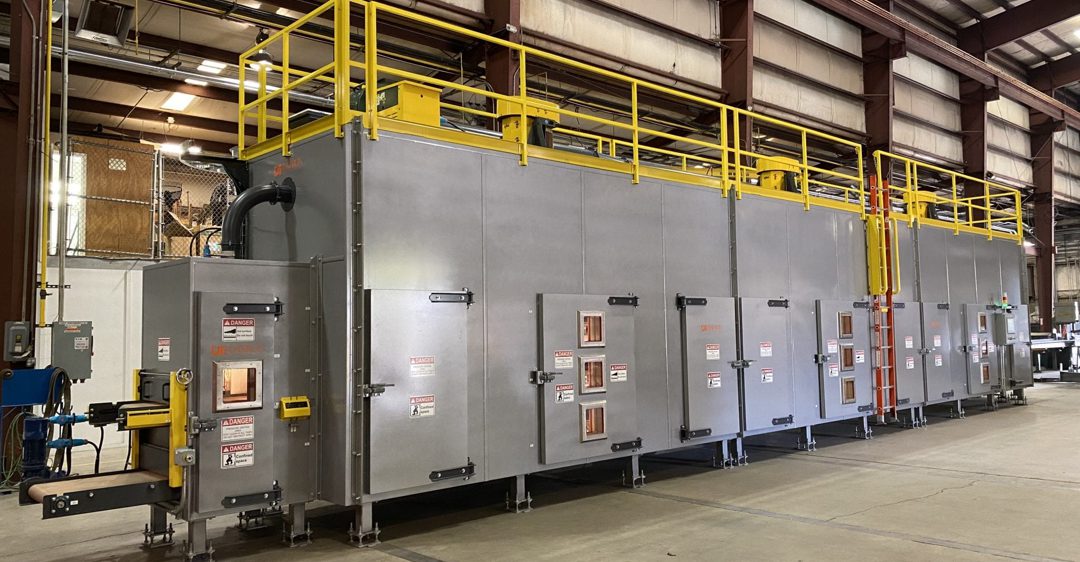Successful production of extruded web-type foam depends on two key processing stages: crosslinking and expansion.
Careful application of heat triggers the chemical reactions that form the initial bonds between polymer chains and then activates blowing agents that expand the product to its final dimensions.
But polymer chemistry borders on sorcery. Even the most minor tweaks in recipes form the basis of products as diverse as garage door insulation, mattresses, football helmets and pool floats.

That leaves facility and production engineers with the difficult challenge of specifying crosslinking and expansion machinery capable of achieving very specific finished qualities reliably and at scale.
Here’s what they need to know.
Optimizing heat delivery for crosslinking foam
We’ll keep this discussion focused on “extruded web-type foam.”
In truth, crosslinking is not nearly as sensitive a step as expansion. Engineers simply need to determine what temperature the work needs to reach — and for how long — so that crosslinking occurs.
The best way to heat extrusions is via forced air brought to temperature by natural gas burners. But the way this hot air is delivered is critical: The airflow and temperature each must be uniform across the surface area of the extrusion so that crosslinking is even and consistent.
Burning natural gas is not the only way to heat air, but it is by far the most effective for this application. Electric heating, for example, would be inappropriate due to the immense energy load required to heat high volumes of air. It’s really, really expensive; natural gas is far more efficient.
However, even though crosslinking is the less complicated stage in the process, that doesn’t mean just any old conveyor oven can do it.
The staggering variability in foam formulas means there can be staggering variation in the heating and airflow parameters needed to achieve the specified end result.
This is why custom-engineered foam crosslinking ovens are ideal in the foam industry. Aware of the potentially great variability in formulas and processing requirements, Davron’s engineers design foam crosslinking ovens with wider control over temperature and airflow. That gives our equipment two important advantages:
First, it allows production teams to dial in the perfect processing conditions for unique products.
Second, gives teams the flexibility to identify the parameters that will achieve uniform product quality at increased production rates.
See foam crosslinking oven examples
If you’re interested in examples of foam crosslinking ovens, check out the following:
- This continuous conveyor oven includes both crosslinking and expansion stages
- This crosslink conveyor also features post-heating processing capabilities including cooling, slitting, shearing and slab stacking
- This unique system is a triple-decker conveyor, custom-designed for the confines of a customer’s existing manufacturing line
Curious whether we can advise on machinery for manufacturing foam that isn’t extruded web-type? Contact us to find out. We’re confident we can help answer your questions.

The secrets to successful foam expansion
Expansion is where the magic happens — and it’s much more complex than crosslinking.
As before, forced air delivers heat to the product to activate the blowing agent. But the speed and evenness of expansion is directly related to the stability of the temperature and evenness of airflow in the oven.
But another essential requirement during expansion is minimizing the web’s contact with the oven conveyor. During the process, foam webs get longer, wider and thicker. This expansion would be hampered if product remained in contact with the conveyor. Instead of an even expansion, the product would bubble and contort.
This is why expansion ovens are often designed to “float” webs off the conveyor with streams of air delivered from below. When this airflow is correctly calibrated, the web’s expansion in every direction is optimized.
Successful foam expansion ovens usually also feature multiple zones of heating and airflow. Just as in crosslinking, when operators have better control over the heating and airflow parameters throughout the expansion process, they can tweak settings to identify the ones that allow a wide range of products to be processed.
Heating control is achieved by installing multiple burners that operators control independently. Variable airflow, meanwhile, is achieved either by multiple fans each with its own ductwork, or by a single fan pushing air through common ductwork punctuated by specially engineered and independently controllable dampers.
Compare the flexibility of multi-zone expansion ovens to the inflexibility of an oven that has only one zone: Despite operators’ best efforts, single-zone ovens limit the process flexibility they would need to process a wide range of products.
Future-proof your foam manufacturing
We hinted at it earlier, but custom-engineered ovens for crosslinking and expanding foam do more than solve present-day manufacturing challenges.
The same qualities that make them great for regular production of proprietary foam formulas make them ideal for testing new ones. And, provided there was enough forethought during engineering, they can also end up saving money and streamlining operations by being the primary system for manufacturing a wider variety of product types.
You’re going to need that versatility if you hope to keep up with the foam chemists in the lab. With the right custom oven, you can even show them some sorcery of your own.
Want to explore options? Send us some rough specs.






